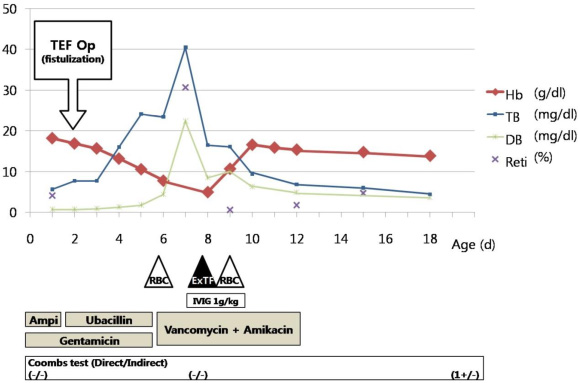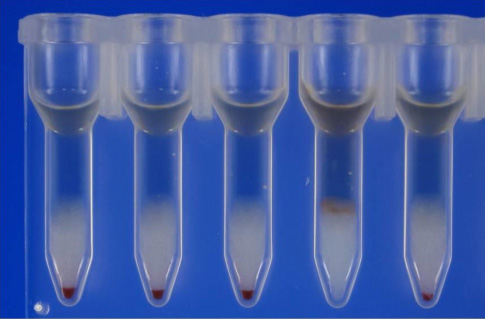Perinatology.
2016 Sep;27(3):190-193. 10.14734/PN.2016.27.3.190.
Ampicillin/Sulbactam-induced Hemolytic Anemia Manifested as Hyperbilirubinemia in a Preterm Infant
- Affiliations
-
- 1Department of Pediatrics, Hanyang University College of Medicine, Seoul, Korea. neopark@hanyang.ac.kr
- 2Department of Laboratory Medicine, Inje University Sanggye Paik Hospital, Seoul, Korea.
- KMID: 2355580
- DOI: http://doi.org/10.14734/PN.2016.27.3.190
Abstract
- A female was born at 36âºâµ weeks of gestation with a birth weight of 2,120 g. Apgar score was 7 at 1 minute and 9 at 5 minutes. Shortly after birth, tachypnea, chest retraction, and a severe build-up of oral secretions were noted. Her blood type was A⺠and initial hemoglobin was 17.5 g/dl. Her mother was A⺠blood type. Ampicillin/Sulbactam and gentamicin were started empirically. At 8th day of admission, laboratory results showed hemolytic anemia. Exchange transfusion was performed along with intravenous immunoglobulin and hydrocortisone. After 2 days, the patient's clinical and laboratory conditions improved. Column hemagglutination assay revealed that the patient's hemolysis was due to ampicillin/sulbactam.
MeSH Terms
Figure
Reference
-
1. Arndt PA, Garratty G. The changing spectrum of drug-induced immune hemolytic anemia. Semin Hematol. 2005; 42:137–144.
Article2. Garratty G. Drug-induced immune hemolytic anemia. Hematology Am Soc Hematol Educ Program. 2009; 73–79.
Article3. Salama A. Drug-induced immune hemolytic anemia. Expert Opin Drug Saf. 2009; 8:73–79.
Article4. Baek EJ, Lee S, Kim S, Choi HK, Kim HO. A case of immune hemolytic anemia induced by ceftizoxime and cefobactam (sulbactam/cefoperazone). Korean J Lab Med. 2009; 29:578–584.
Article5. Rao KV. Drug-Induced Hematologic Disorders. In : DiPiro JT, Talbert RL, Yee GC, Matzke GR, Wells BG, Posey L, editors. Pharmacotherapy: a pathophysiologic approach. 9th ed. New York: McGraw-Hill;2014. p. 647–661.6. Mintzer DM, Billet SN, Chmielewski L. Drug-induced hematologic syndromes. Adv Hematol [serial online];2009. 01-12. 01(01):[24screens]. cited 2009 Jul. Available fromhttps://www.hindawi.com/journals/ah.7. Claas FH. Immune mechanisms leading to drug-induced blood dyscrasias. Eur J Haematol Suppl. 1996; 60:64–68.
Article8. Garratty G. Immune hemolytic anemia associated with drug therapy. Blood Rev. 2010; 24:143–150.
Article9. Mayer B, Yurek S, Salama A. Piperacillin-induced immune hemolysis: new cases and a concise review of the literature. Transfusion. 2010; 50:1135–1138.
Article10. Garratty G, Arndt PA. Positive direct antiglobulin tests and haemolytic anaemia following therapy with beta-lactamase inhibitor containing drugs may be associated with nonimmunologic adsorption of protein onto red blood cells. Br J Haematol. 1998; 100:777–783.
Article11. Leger RM, Arndt PA, Garratty G. Serological studies of piperacillin antibodies. Transfusion. 2008; 48:2429–2434.
Article12. Johnson ST, Fueger JT, Gottschall JL. One center's experience: the serology and drugs associated with drug-induced immune hemolytic anemia--a new paradigm. Transfusion. 2007; 47:697–702.
Article13. Kamesaki T, Oyamada T, Omine M, Ozawa K, Kajii E. Cut-off value of red-blood-cell-bound IgG for the diagnosis of Coombs-negative autoimmune hemolytic anemia. Am J Hematol. 2009; 84:98–101.
Article14. Arndt PA, Leger RM, Garratty G. Serology of antibodies to second- and third-generation cephalosporins associated with immune hemolytic anemia and/or positive direct antiglobulin tests. Transfusion. 1999; 39:1239–1246.
Article
- Full Text Links
- Actions
-
Cited
- CITED
-
- Close
- Share
- Similar articles
-
- Jaundice and Hemolytic Anemia Appearing within the First 24 Hour of Life due to Glucose-6-Phosphate Dehydrogenase Deficiency
- A Case of Congenital Hemolytic Anemia of Unknown Cause Combined with Gilbert's Syndrome
- A Case of Immune Hemolytic Anemia Induced by Ceftizoxime and Cefobactam (Sulbactam/Cefoperazone)
- Efficacy and Safety of Amoxicillin-sulbactam and Ampicillin-sulbactam in Full Term Neonates
- Hemolytic Disease of the Newborn Caused by Anti-M in 2 Male Siblings



